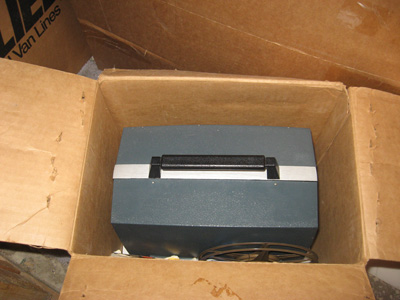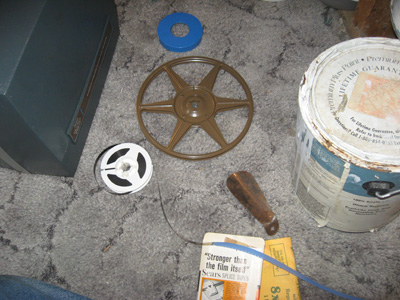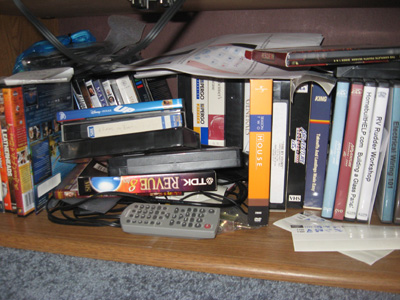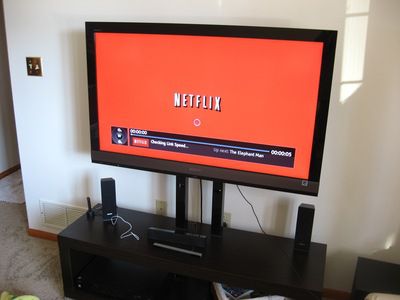Yesterday, Netflix announced that it will begin to offer a lower-priced package for people who would rather stream movies than get a DVD in the mail. It’s big news in tech circles today and judging by the number of blogs I’ve read today, people are switching their plans without giving it a thought.
I, however, did.
Netflix’s announcement has spawned another panic attack that my family’s analog — and now, digital — history is disappearing in a hurry and I probably shouldn’t put off saving it any longer. But save it… to what?
Over the weekend, I crawled into the space under the stairs to get the Christmas tree and decorations (the earliest I’ve ever done that so I’m not completely losing the non-procrastinator war) and stumbled across this:

It’s a Super 8 mm movie projector, still apparently in good shape after 20+ years of no use. Inside was this treasure:

A take-up reel (this was once an “every day expression”), a rusty shoe horn (beats me, but I think I’ve used the projector more recently than the shoe horn) and the only roll of film I ever shot of my oldest son, on his first days home from the hospital more than 25 years ago.
What would you do now? That’s exactly what I did.
Unless I get around to finding some place that will convert Super 8mm film to digital, that history is gone. Forever. When I was growing up, my parents had a huge drawer of these films, documenting the lives of me and my four brothers and sisters. As far as I know, that’s all gone now, too.
My house is full of disappearing history. In closets and cabinets all over the house, there are VHS cassettes — unindexed — occupying space. I didn’t shoot a lot of video of the kids — I didn’t want to be that guy — but what little I shot is around here somewhere.

And if I ever find it, this is the last remaining VHS player in the house: the old TV.

Another one died a month or so ago and has left us permanently. When this one goes, all that VHS history probably goes too, unless I get around to transferring it to another media — perhaps DVD. Underneath the TV is a DVD player we bought when VHS started to disappear.
This week, an old desktop PC which has most of my digital images started dying. Of all the important data that’s on it, my first action was to save the pictures — our history. I burned them all onto a DVD.
And that will work fine, until DVD players disappear too. That will probably happen in my house, because last month we bought this:
It’s a home-entertainment system that connects to the Internet and allows us to stream video. No DVDs necessary. This is why Netflix did what it did yesterday. And this is why all the other media in the house is nearly obsolete.
I’m not recommending we go back to the old days. But as technology moves along at an ever-increasing pace, it makes it difficult for us to preserve our visual histories. Maybe today you’ll upload your images to Picassa, or a blog, or Flickr, or Facebook, or leave them on your phone, not thinking that there’s no guarantee Picassa, your blog, or Flickr, or Facebook, or your phone technology will be there 30 years from now, any more than there was a guarantee that my movie projector would work today. Maybe that doesn’t matter to you now, but it’ll matter in 30 years. Trust me on this.
Now here’s the odd part: Of all the technology that exists and has existed to preserve our histories, this is still the one that seems to work the best over time in my house: a shoebox.
Beat that Netflix.


